


China’s reform roadmap globally relevant

Photo taken on Aug. 13 shows wind turbine blades at the Penglai Port in Yantai, Shandong Province. The port has facilitated the export of China-made wind-power equipment to more than 20 countries and regions around the world. Photo: XINHUA
Against the backdrop of the complex and shifting domestic and international landscape, China held the Third Plenary Session of the 20th CPC Central Committee in mid-July. At this landmark meeting, a resolution on further deepening reform comprehensively to advance Chinese modernization was adopted, igniting widespread discussions among experts and scholars at home and abroad. To interpret the far-reaching implications of the key CPC plenum and its potential impact on global governance, CSST recently interviewed Xulio Ríos, founder and honorary president of the Galician Institute of International Analysis and Documentation in Spain and director of the Chinese Policy Observatory in Spain.
More comprehensive, profound reform
Commenting on the significance of the third plenary session, Ríos explained that it defines the crucial period in China’s development, of building a strong country in all respects through Chinese modernization and striving to achieve national rejuvenation. There is full awareness among the leadership of the challenges that lie ahead, alongside a thorough diagnosis that specifies the areas where immediate action is necessary to address the structural dilemmas of reform.
The resolution adopted at the plenum suggests a blueprint for the comprehensive reform and a layout of its perimeter, Ríos noted. There are aspects that are noteworthy: from market expansion to the commitment to innovation as a talisman, as well as the intensification of the social and structural reforms across various sectors. “All of these are indicative of the relevance of the measures that await us, of varying magnitude, which will be complemented by an update of the institutional framework so that the systemic improvement of governance is established as a driving mechanism and does not hinder innovations,” he stated.
The roadmap thus drawn up is based on a characterization of the main contradiction in this phase, that between the people’s growing need for a better life and unbalanced and inadequate development, Ríos continued. “Major reforms are required in numerous areas so that the wellbeing of the people accompanies the growth of wealth and prevails by bringing it closer to the greatest possible number of households. Improving the standard of living of the population and the standard of living in terms of housing and education, for example, are factors that stimulate inclusive development and offer a new vector of economic momentum.”
Ríos summarized that China is heading into a phase of more comprehensive and profound reform, with a strong reaffirmation of its goals and objectives, particularly those set for 2035. “These will not be easy reforms, but transformation is undoubtedly possible. No one would have imagined a short time ago, for example, that China could overtake Japan, as it did in 2023, as the world’s largest exporter of cars, or the position achieved in the global energy transition that today depends on solar panels, wind turbines or batteries produced in China.”
Distinctive Chinese modernization
Discussing Chinese modernization, Ríos told CSST that it is a long historical process that can be traced back to the end of the 19th century. Over the years, China has experimented with different approaches to overcome its backwardness and underdevelopment. “Since the proclamation of the People’s Republic of China, which will now celebrate its 75th anniversary, we have been able to observe a process of constant progress amidst a very original exploration. It was precisely in the framework of another third plenum, that of the 11th CPC Central Committee in 1978, that the main bases of reform and opening were laid. And in another third plenum, that of the 18th CPC Central Committee in 2013, when it was decided to comprehensively deepen it.”
Throughout these transformations, it is worth highlighting China’s approach to modernization has consistently adhered to distinctly Chinese foundations. This means a reaffirmation of the principles, orientations, and balances that consider the unique characteristics of China’s development process, all under the continued leadership of the CPC, Ríos said.
Global significance
Ríos emphasized that success at this stage will elevate China’s global status and will create new opportunities to transcend the protectionist policies that certain countries employ to hinder China’s progress. “The transformation of the global geo-economy is inevitable at the hands of China and, supported by frameworks such as the BRICS and their platforms, the New Development Bank, or projects such as the Belt and Road Initiative and institutions such as the Asian Infrastructure Investment Bank, it will receive an important boost in the coming years.”
“The new dynamism of the Chinese economy and the new role of the Global South will have a significant impact on areas of global governance, operating new and necessary balances. It is an unstoppable historical trend,” Ríos predicted.
“We must not lose sight of the fact that this is a modernizing drive that will circulate on two wheels: one in China, and one in the world. And both feed off each other. Therefore, the better China does, the better the world will do,” he added.
Ríos further observed that China has been actively working to build bridges with other countries to address common challenges, such as climate challenge, regional conflicts, or even the curbing of protectionist tendencies. “And just as internally we must avoid being trapped in traditional ideological demarcations, externally it is important to explore overcoming the limits in use. It is time, for everyone, to think about solutions,” he appealed.
Editor:Yu Hui
Copyright©2023 CSSN All Rights Reserved